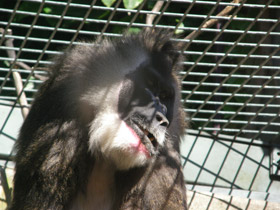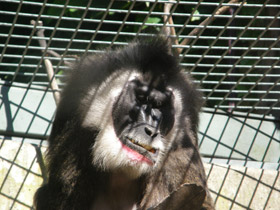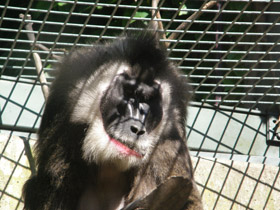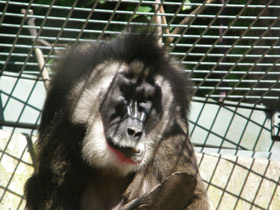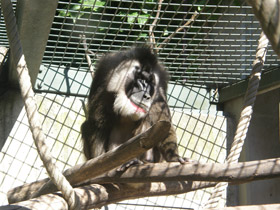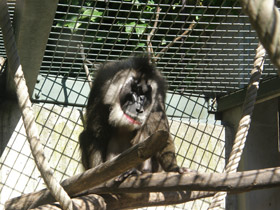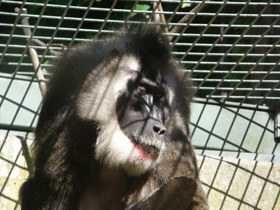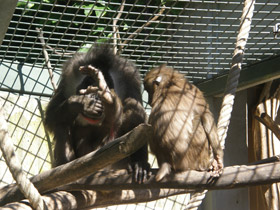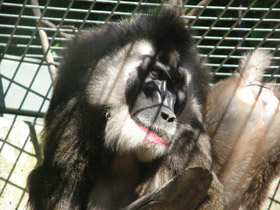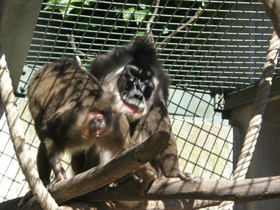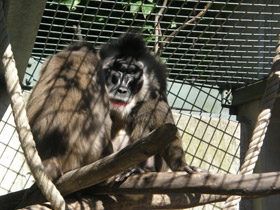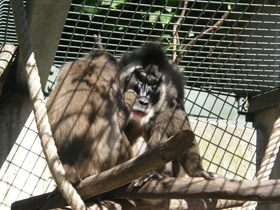The drill (Mandrillus leucophaeus)
The drill (Mandrillus leucophaeus) is a related to baboons and even more closely to mandrills.
Habitat area and appearance
The drill (Mandrillus leucophaeus) is a species of catarrhine primate of the family Cercopithecidae similar in appearance to the mandrill, but without the latter's brightly coloured face. Mandrillus leucophaeus is found in Cameroon, southeastern Nigeria and Bioko Island. The face of the bore is almost hairless, its front is visibly elongated and there are bony grooves along the nose. The turkey's coat is dark brown to black, quite thick and covers almost the entire body except for the buttocks, which are bright red or blue in the bore. The hands of Mandrillus leucophaeus have slender, well-developed fingers, similar to those of humans. Mandrillus leucophaeus is a large monkey, with a body length of 60-75 cm and a weight of 20 kg, while males are twice as large as females, sometimes weighing up to 50 kg.
Lifestyle and nutrition
Mandrillus leucophaeus, which lives in tropical forests, spends most of its time on the ground, moving on all four limbs. Here they seek their subsistence: edible mushrooms, nuts, sweet fruits, insects and occasionally small mammals. Fleeing from predators, females with their young climb the thick branches of trees; males prefer active defence: they attack their enemies so fiercely, baring their fangs and throwing stones and sticks, that even leopards are afraid of them.
Social behaviour and reproduction
Mandrillus leucophaeus usually stays in groups of 20-25 individuals, consisting of a male, several females and their young. Sometimes several groups join together and more than 200 monkeys live peacefully in the same area for some time. Gestation lasts about 7 months and ends with the birth of a calf, which is cared for only by the female. The male is mainly engaged in protecting the territory from competitors.
Mandrillus leucophaeus in the Red Data Book
The survival of Mandrillus leucophaeus as a species is currently in doubt, with an estimated population of only 3,000 individuals. Mandrillus leucophaeus is listed in the Red Data Book of the International Union for Conservation of Nature. Destruction of tropical forests and hunting remain its main threats.
Conservation
Drills are among Africa’s most endangered mammals, and are listed by the IUCN as the highest conservation priority of all African primates. Drill numbers have been declining in all known habitat areas for decades as a result of illegal commercial hunting, habitat destruction, and human development; as few as 3,000 drills may remain in the wild, with the highest population estimate only 8,000. A total of 174 drills recovered from illegal capture are in semicaptivity at the Drill Rehabilitation and Breeding Centre in Nigeria, with high success rates in breeding recorded there, and about 40 in other zoos internationally.
Taxonomy
Two subspecies of drill are accepted by some authorities, but are not considered distinct by others:
- Mainland drill, Mandrillus leucophaeus leucophaeus;
- Bioko drill, Mandrillus leucophaeus poensis.
Their closest relative is the mandrill (Mandrillus sphinx), found from southern Cameroon through mainland Equatorial Guinea (Rio Muni), Gabon and into the Congo. The two species are allopatric across the Sanaga River.

















